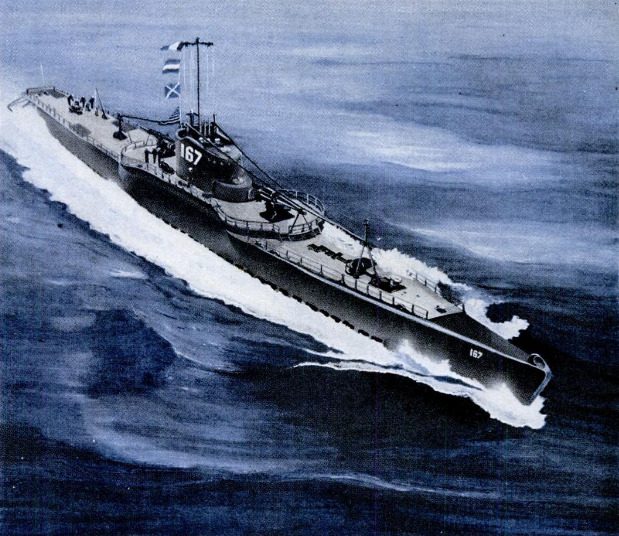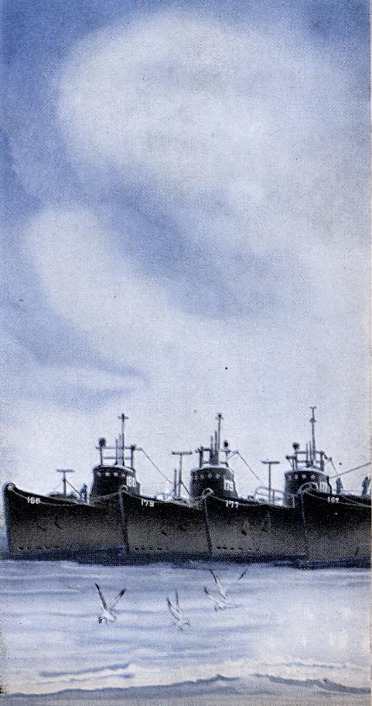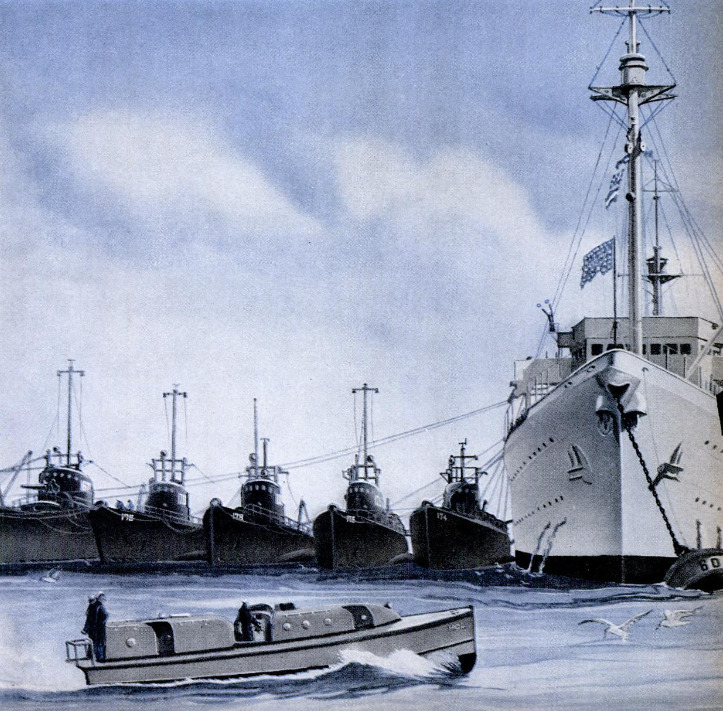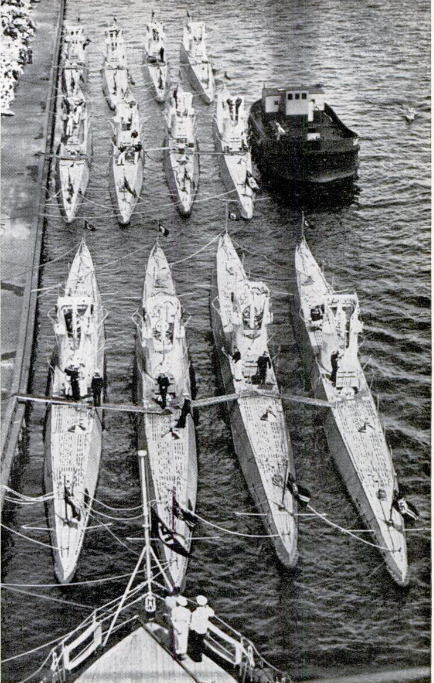-
Title (Dublin Core)
-
Submarines in war
-
Article Title and/or Image Caption (Dublin Core)
-
Title: Submarines in war
-
extracted text (Extract Text)
-
JUST what is a submarine? It is a war-
ship designed for traveling under water
and attacking its enemy unobserved
with torpedoes. Its ability to surprise is the
submarine’s most important attribute.
A surface warship, when overtaken or en-
countered by an enemy, must stand and
fight, unless it has sufficient speed to run
away. A submarine need not fight, nor need
it show its heels to an enemy ship. All it
need do is submerge, and the surface enemy
is baffled.
The value of the submarine has not
changed markedly since World War I. It
has been improved, of course. Engines are
more reliable and noiseless, better and
greater-capacity storage batteries are in-
stalled, more rugged motors are fitted. Tor-
pedoes have been improved in accuracy, and
run with greater precision. More scientific
methods of submerging have been achieved
and the many instruments and devices used
in underwater navigation have become more
accurate and reliable. Underwater listening
devices in submarines have been developed
to such an extent that submarines now can
fire their torpedoes using direction finders on
the listening-device principle without show-
ing their periscopes.
Submarines today are even more of a
menace to shipping than they were in World
War I. This is due, almost entirely, to the
relatively fewer antisubmarine vessels avail-
able to combat them. The security of the
commerce of any nation fighting another
with a large submarine fleet is almost in
direct proportion to the number of anti-
submarine vessels that can be pressed into
service. Convoys must funnel into known
ports, and therefore submarines can strike
at them with a minimum of cruising. These
submarines need only take up their stations
where the trade routes converge. The con-
voy system is none too simple to work out
successfully. Merchant ships are of differ-
ent speeds, and the speed of a convoy is that
of the slowest vessel. Faster ships have
been placed in convoys by themselves, but
this increases the number of convoys being
used, and many more warships for escort
are needed. The inexperience of merchant-
marine personnel in maneuvering their ships
in close formation is another difficulty. The
lack of experience in handling ships
causes a spread of vessels in convoy,
permitting a submarine to attack
stragglers that are left without proper
escort. This fault increases enormous.
ly the arduous duties of destroyers.
The submarines most important
function is to intercept a warship or
merchant ship, using first stealth and
then invisibility to arrive at a position
from which to torpedo the target vessel.
That seems simple enough to state,
but its accomplishment is not so easy,
nor is it entirely without risk to the
submarine.
The merchant ship or warship may
be a part of a convoy of many vessels.
There may be a number of antisub-
marine vessels present with the con-
voy, the most effective for the purpose
being the very fast destroyer. The
submarine is under water and there-
fore invisible. When it has arrived at
a position from which its torpedoes can
hardly miss, it fires its missiles. At this
moment, it reveals its presence to all
the vessels of the convoy, and then its
troubles begin.
In the bow of the submarine, and
sometimes also in its stern, are tor-
pedo tubes. When a torpedo is fired
from any of these tubes, with either
a powder charge or compressed air,
there is created a large bubble of gas
or air on the surface of the sea above
the submarine. If an antisubmarine
vessel, say a destroyer, is alert, that
bubble gives information just Where
the submerged vessel is located. Then
the destroyer charges down to the spot and
lays a depth-charge barrage all about the
position of the hidden submarine.
The torpedo or torpedoes—oftentimes two
or even more are fired simultaneously at a
particularly valuable target—are then on
their way towards the victim. They leave a
white wake behind them, caused by the air
bubbles from the exhaust of their speeding
turbines. These wakes can be seen by the
attacked vessel and by the destroyers in
the escort, and depending upon the distance
from which the submarine has fired its
shots, the attacked ship has an opportunity
to maneuver to avoid the torpedoes.
The submarine, after discharging its
death-dealing missiles, has an important de-
fensive role to play to save itself from
destruction. This is to avoid the depth-
charge barrage certain to be laid about it.
When the torpedoes were fired, the sub-
marine was at periscope depth a depth
under water from which it could raise the
telescoping eyepiece of the periscope above
water to observe its target. The first thing
for the submarine to do then is to dive as
quickly as possible. From a depth of about
35 feet, it uses its horizontal rudders to
carry it to as great a depth as its hull will
permit, which is not far from 200 feet, and
at once changes its course radically, while
increasing its underwater speed. This will
carry the submarine out of the danger zone
as rapidly as possible.
A depth charge must explode fairly close
to a submarine in order to wreck it, 50 a
submarine attacked by a destroyer still has
a good chance of escape. Destroyers carry
from 40 to 50 depth charges, and they are
most generous with them. Depth charges
are usually set for detonating at about 100
feet. The depth-charge explosion is & point
and the force of the explosion is mostly up-
wards. Thus a cone of pressure is formed,
its size depending upon the depth at which
the charge explodes. If any part of the
submarine is within this cone of pressure,
the effect on the submarine is serious, caus-
ing extreme pressure on every part of the
hull, and consequent leaks. If the hull of the
submarine is outside the zone of pressure,
the effect is less. But even then, the shock of
the explosion will cause the submarine to be
badly shaken up, putting out lights and leav-
ing the personnel in darkness, causing circuit
breakers to blow, and in general disturbing
the morale of the crew. Depth charges ex-
ploding as far as 200 feet away have been
known to cause the personnel of a sub-
marine to lose their nerve, blow ballast
tanks, and bring their vessel to the surface,
to be sunk by gunfire or captured.
While on the surface a submarine is pro-
pelled by Diesel engines. On the propeller
shafts are large electric motors, used for
power in underwater navigation. Large
storage batteries supply the power to the
motors. These motors can be driven by the
engines as generators to recharge the stor-
age batteries. This recharging can be ac-
complished only while the submarine is on
the surface. Recharging of batteries can
be done also when running on engines on
the surface by what is known as “floating
the batteries on the line.”
"T
HE engines give the submarine a surface |
speed of 13 to 20 knots, depending upon
the type of submarine. The large fleet sub.
‘marines are given a higher speed of about
20 knots in order that they can accompany
the battleships. The high underwater speed
on battery and motors is seldom over ten
knots.
A submarines battery capacity is an im.
portant item for maneuverability submerged
nd also for safety. The battery speed of ten
knots can be maintained for only an hour.
Alter that, a speed of three to four knots
can’ be continued for several hours. When |
the battery capacity has been used up, the
submarine must come to the surface to ro
Charge batteries, Just as an airplane must
land when Its gasoline tanks are empty. |
Modern submarines are capable of remain.
ing submerged for upwards of 24 hours by |
running only at & low submerged speed,
about three knots, until the battery is used |
up. That is the renson why so great a |
proportion of submarines escape from de-
stroyers after having attacked convoys.
Darkness often will intervene before the
battery ls exhausted, and the submarine can
escape on the surface under cover of night. |
‘One of the submarine's limitations ia in
its inability to prevent antisubmarine ves-
sels from tracking it by using their listening |
devices. Listening devices have been greatly |
improved since World War I. In 1018, oven
with Inefficient listening devices fitted In
antisubmarine vessels, the German submar-
ines suffered a breakdown of morale owing |
to the large number sunk by destroyer depth
charges. The British Admiralty gave no re-
ports on submarine sinkings, and the Ger-
mans only knew that submarines never |
returned to their bases.
A convoy is usually formed in columns of
‘vessels, with the leaders In line. The distance
between snips is maintained as close as the |
experience of the personnel seems to war-
rant, bearing in mind that danger from
collision is as great a risk as even submarine
attack.
‘The escort is placed on the outside of the
columns. The destroyers or other antisub-
‘marine vessels are stationed close in where
they can turn quickly and steam to the loca-
tion of the attacking submarine. Cruisers
and even battleships and airplane carriers
are located far out on the flanks of a convoy,
to shield the mass of merchant ships from
the gunfire of an attacking surface raider.
The submarine may be informed of the
Tocation of a convoy by patrol planes while
yet the convoy is out of sight. Then the
submarine will use its engines on the surface
to place itself in the path of the convoy.
Before being discovered by the escort, the
submarine submerges and runs on its bat-
tery and motors. During this latter time the
submarine will be at periscope depth, or
about 35 feet, and uses its periscope obser-
vations to correct its position relative to the
selected target. When a correct position is
reached, within short range of its Intended
victim, the submarine will fir its torpedoes,
using its periscope for accurate aim, or else
fire the torpedoes while completely sub-
merged, employing the listening device to
give the angles of sight for the torpedoes.
The submarine can carry only a limited
number of torpedoes, so It will attempt to
reach a distance from which a miss 18 im.
possible, although the torpedo will run ac-
curately for a distance of 3,000 yards or
more, The ideal position for firing 1s within
1,000 yards of the enemy vessel. Such a
maneuver makes the submarine’s part a
most hazardous one.
Long-distance planes often serve as the
eyes for a submarine fleet. Communication
between the underwater vessels and the
‘planes is by radio. A submarine can use its
radio while submerged to communicate with
other submarines and with airplanes. Be-
tween submarines, communication by radio
is practical up to 100 miles. On the surface,
the radio equipment of a submarine is equal
in performance to that of a surface warship.
THE airplane bomber has proved most
effective against submarines. Oftentimes
the submarine can be surprised while on the
surface and bombed before it can submerge.
Bulletproof armor is carried on the exposed
parts of a submarine’s hull, but otherwise
the hull is most vulnerable to shellfire. A
surface vessel can receive a number of shell
hits on its hull without seriously impairing
its seaworthiness, but not so with the sub-
marine. One shell hit, and the submarine
will be unable to submerge.
The personnel of submarines must all be
men of experience. They are usually of the
petty officer's rating, es-
pecially trained for the
duty. In the U. 8. Navy
a submarine school 1s
‘maintained to train off
cers and men for this ex-
acting service. Crews are
usually made up from
volunteers aelected for
courage, who can stand
the enormous strain of
submarine duty without
loss of morale. Few men
in’ submarines are over
35 yearn old, and mot of
them are much younger.
The modern United
‘States submerine ina ves-
sel of about 1,400 tons
surface displacement. Its
principal characteristics
are habitabllity, long
crulsing radius, high sur-
face speed (20 knots) and
submerged speed (10
knots for one hour), and
the ability to remain 24
hours under water at
three knots speed before
the batteries are
completely discharged.
Torpedo rooms are large
enough to carry from 15
£0 20 torpedoes. The sub-
‘marine is given most ef.
ficient ventilation, and
the means of extracting
impurities from the air
and supplying oxygen de-
ficiencies, when sub.
merged,
The role of our United
States submarines in war
is to take the offensive
off the coast of an enemy.
They are a mazimums-
purpose vessel, and can
operate both against the
enemy's lines of com-
munication at consider-
able distance from their base, and likewise
off our own coast line to break an enemy's
blockade.
The submarine is said to be the weapon of
the weaker sea power. It is relatively inex-
pensive to build, as compared with the large
surface warships. A submarine of the 1,400-
ton type costs about $5,000,000, while a
cruiser costs upwards of $15,000,000 and a
battleship as high as $70,000,000. The sub-
marine is a weapon of great promise, men-
acing warships and merchant ships alike
in all parts of the ocean. In cosperation with
airplanes it can extend its vision for hun-
dreds of miles, and it can operate without
support from any other vessels.
In war the command of the surface of the
sea belongs to the side that owns the most
numerous and formidable fleet of surface
warships. This advantage enables that side
to use the sea with its merchant shipping
and all its warships. The weaker side in
surface warships cannot command the sur-
face of the sea. This is the reason Germany
has used submarines to torpedo every vessel
that sails the sea. Everything that moves
on the surface is considered by the sub-
marine as an enemy.
-
Contributor (Dublin Core)
-
Yates Stirling (article writer)
-
Language (Dublin Core)
-
Eng
-
Date Issued (Dublin Core)
-
1941-06
-
pages (Bibliographic Ontology)
-
81-85
-
Rights (Dublin Core)
-
Public domain
-
Archived by (Dublin Core)
-
Sami Akbiyik
 Popular Science Monthly, v. 138, n. 6, 1941
Popular Science Monthly, v. 138, n. 6, 1941








